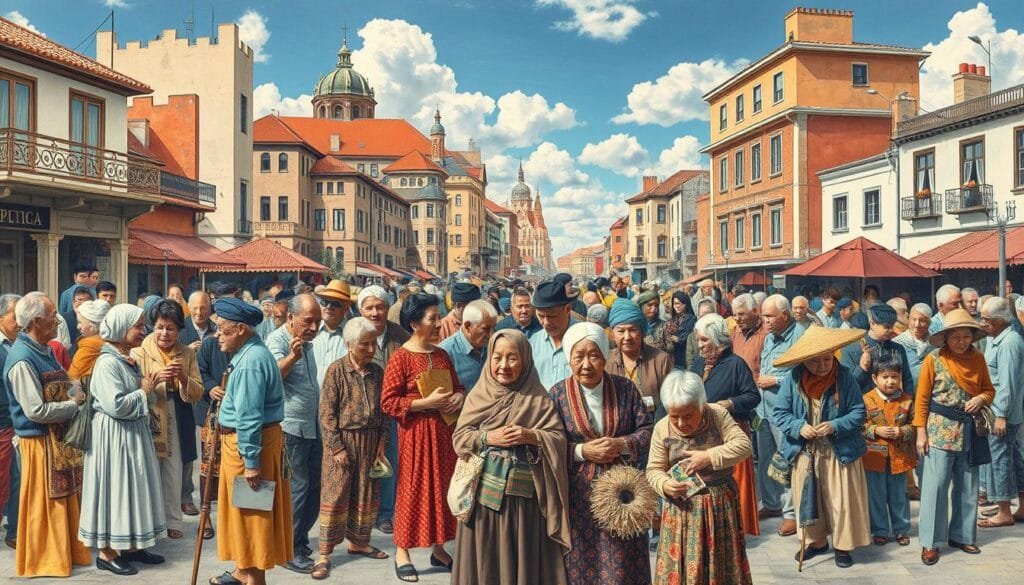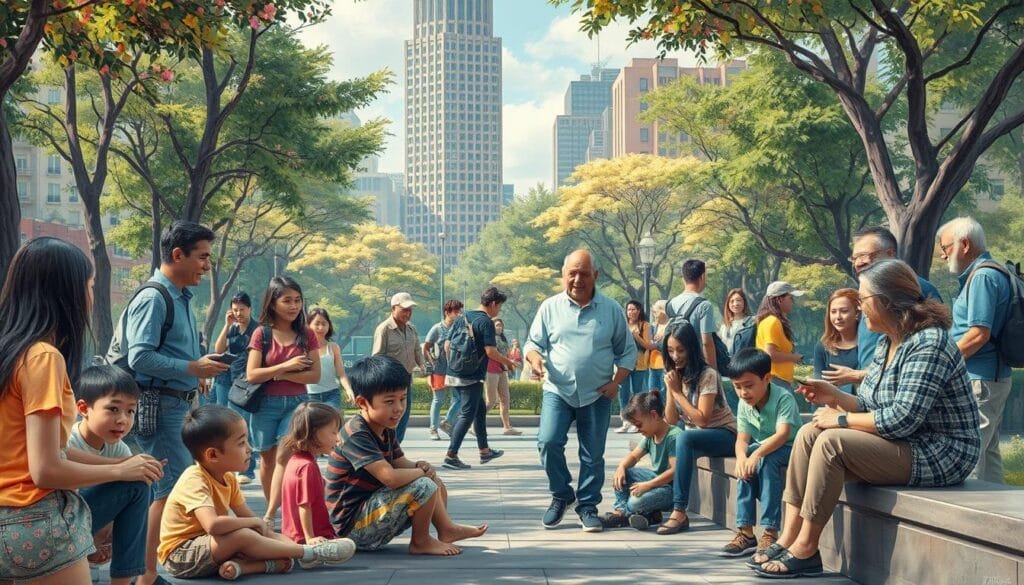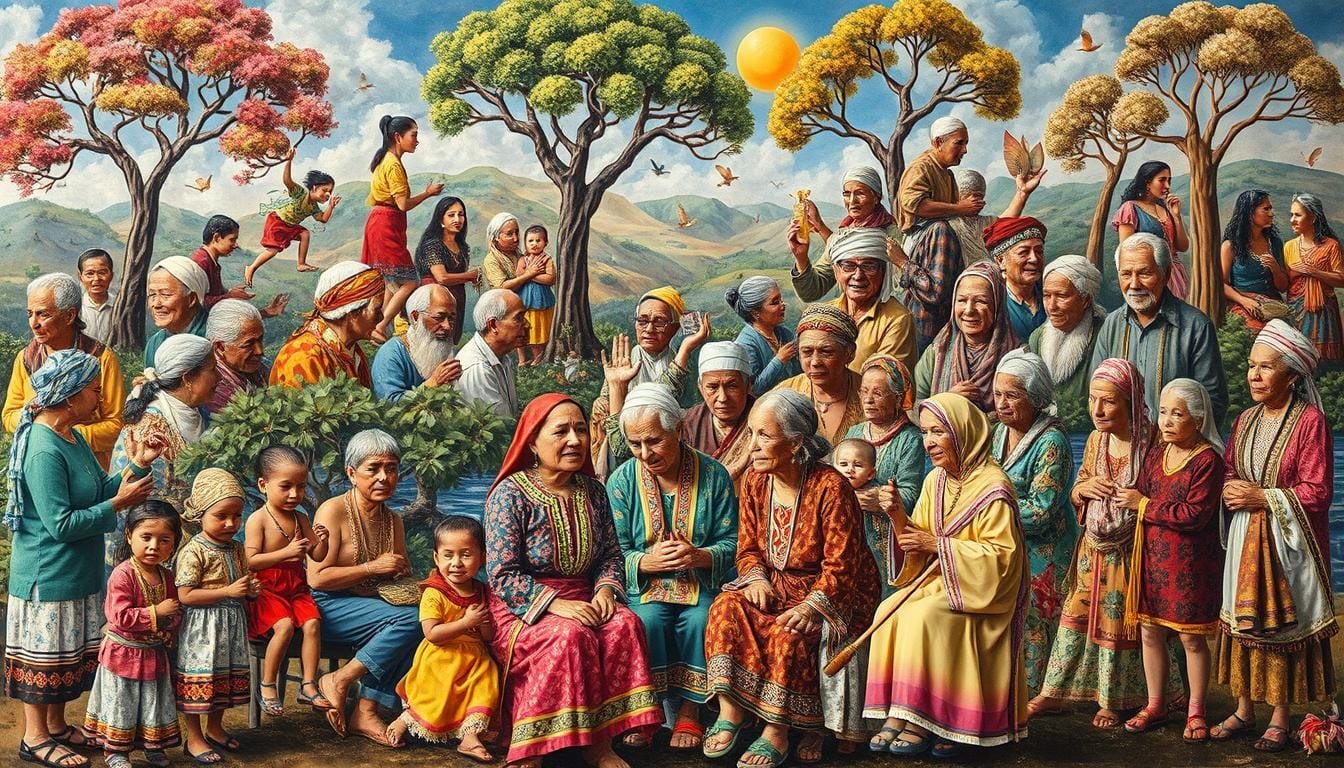How do we see ourselves as we get older? Could our views be based on our culture, not just our age? Age identity involves more than just how old we are. It’s tied to our culture’s norms and what society expects of us. Like race, class, and gender, age helps us describe ourselves. It changes based on our social experiences.
In China, people over 60 often feel they are 70. This shows how culture shapes our view of aging. Around 226 million elderly people live in China. Globally, 13% of people were elderly in 2017. This makes age a key cultural category.
Experts believe understanding aging’s societal impact is vital. For instance, life expectancy in China has risen from 67.9 to 76.5 years recently. This change requires us to rethink age. We must consider how it influences our interaction with the world and ourselves.
Key Takeaways
- Age identity integrates chronological age with cultural norms and societal roles of aging.
- The average old age identity in China for individuals aged 60 and above is around 70 years.
- Global elderly population constituted 13% of the total population in 2017, emphasizing the importance of age identity.
- Life expectancy in China has significantly increased, indicating shifts in cultural perceptions of aging.
- Understanding cultural impacts on age identity is essential for addressing societal views and individual self-perception.
Introduction to Age Identity
Age identity is how we see and feel about our own age. It often differs from our actual years. Understanding age identity is crucial. It shapes our self-view and how society sees us. Let’s dive into what age identity means, its importance, and its history.
Defining Age Identity
Age identity is about the value we give to our age. It affects how we see ourselves and how others view us. For example, feeling younger can lead to better health and happiness in later years. This shows how our age perception plays a key role.
The Importance of Age Identity
Age identity touches many parts of life. It matters in policy making and daily interactions. For example, most older people in the West wish they were younger. Age identity also shapes schools, promoting inclusive practices.
Historical Perspectives on Age Identity
Age identity has a long history. In the past, age decided one’s role in society. Now, views on aging are more varied. For instance, in Senegal, where people live to about 59 years, many wish to be younger. This shows how age identity has changed over time.
Psychological Processes Behind Age Identity
Age identity comes from how we view our aging selves. It shapes how we view ourselves and affects how we live through different life stages.
Assimilation and Accommodation
Assimilation and accommodation are key in how we adjust to aging. Assimilation means tweaking our self-view to fit age changes. Accommodation is adjusting our identity due to these changes. These processes help us keep our identity steady over time.

Motives of Self-Continuity and Self-Enhancement
Self-continuity and self-enhancement are core to our age identity. The first aims to preserve our identity over time. The latter seeks to improve how we feel about ourselves. These motives guide how we cope with aging, affecting our happiness and life satisfaction.
| Variables | Description | Prevalence |
|---|---|---|
| Self-Continuity | Maintaining a cohesive identity over time | High in subjective age satisfaction |
| Self-Enhancement | Efforts to improve self-regard | Boosts life satisfaction |
| Assimilation | Aligning self-perception with aging | 75%-80% |
| Accommodation | Reshaping identity due to aging | 20%-25% |
Impact of Psychological Adaptations
These psychological changes have a big impact. Research shows they affect our mental and physical health, how well we think, and our overall happiness. By having a positive view of aging and adapting well, we can keep thriving regardless of our age.
The Sociocultural Impact of Age Identity
Age identity greatly shapes how we see ourselves and interact with the world. Societal views on aging influence everything from accepted aging patterns to roles for different ages. These roles are deeply rooted in our society, affecting politics, the economy, and health care.
For many, becoming a grandparent boosts their sense of identity. Yet, retiring can cause some to feel lost, especially if their job was a big part of who they were. Changes in age impact people differently. Some seniors thrive by taking up new hobbies or volunteering. However, some struggle with mental health issues. Blue Moon Senior Counseling provides help for seniors facing such challenges, which shows growing recognition of these issues.
Society’s view of different ages can lead to stereotypes. This affects how individuals see themselves and others. Some seniors feel ashamed needing help from family. Around retirement, many people’s sense of self changes. They might seek solitude or want more social interaction.

A study with 424 Canadian and Chinese participants revealed older adults felt more continuity in their lives than younger people. This held true in both cultural settings, also leading to higher life satisfaction. Another study, with 91 people aged 18 to 92, showed that older adults felt a stronger connection to their current selves compared to younger ones.
Research suggests that younger people expect happiness to grow with age. However, older adults usually see their well-being as stable. They also remember past happiness and future expectations more accurately. This suggests that a stronger self-continuity can improve how people view their lives and their mental health.
Older adults often see the distant past as closer to the present. This means they tend to focus more on current experiences. Such focus, along with variations in self-continuity, shows the complex effects of societal age views. Emphasizing aging’s role in society, especially regarding mental health and identity, shows the need to cater to older adults’ diverse experiences.
| Sample Group | Age Range | Reported Findings |
|---|---|---|
| Canadian and Chinese Adults | 17-26 years (Young) | Young Chinese reported greater self-continuity than young Canadians |
| 60-88 years (Older) | Older adults reported greater self-continuity compared to younger adults | |
| General Study Participants | 18-92 years | Older adults focused more on the present |
Age Identity Across Different Cultures
Age identity changes from culture to culture. Differences in aging influence how people view themselves and others. In the West, there’s a big focus on looking young. Yet, in the East, like in China, older people are valued for their wisdom.
Western Perspectives vs. Eastern Perspectives
In the West, there’s a battle against aging. People often use cosmetic surgery and anti-aging products. Media pushes the idea that staying young is key, putting pressure on everyone.
On the flip side, Eastern places like China see aging as something to respect. They follow the idea of filial piety, honoring older adults. In China, being old starts at 60. There are about 226 million people over 60, making up 16% of the population. Here, older people play important roles in families and communities.
The Role of Cultural Practices and Beliefs
Eastern cultures have special rituals for respecting the elderly. These traditions help see aging in a good light, creating a caring community.
Western culture, however, values being on your own and putting yourself first. This can lead to fearing aging and negative views on getting older. It’s interesting to see how different beliefs about aging affect us. For instance, around 65% of Middle Easterners in the West keep their cultural views to resist Western influence.
The changes in how we see aging, like Turkey’s turn towards the West, make us think more about age identity. It shows how personal and societal values on aging are linked.
| Aspect | Western Cultures | Eastern Cultures |
|---|---|---|
| Perception of Aging | Value on Youth, Anti-aging Focus | Respect for Elderly, Filial Piety |
| Cultural Practices | Independence, Individualism | Honor Rituals, Family Heritage |
| Societal Views | Age as a Burden, Fight Against Aging | Age as Wisdom, Community Support |
| Media Representation | Glorification of Youth | Positive View of Aging |
| Psychological Impact | Negative Self-Identity | Positive Self-Identity |
To wrap it up, looking into these cultural views helps us better understand aging. Finding a balance could help appreciate aging more, recognizing personal growth at any age.
How Age Identity Influences Social Interactions
Understanding how age identity influences social interactions is important. We must look into key areas where age identity greatly affects our lives.
Perceived vs. Actual Age
There’s a gap between how old we think we are and our real age. This gap affects how we act with others. It happens because of personal and societal factors. These factors impact how we’re viewed and understood.
Our identity starts forming when we are kids. This affects how we see ourselves and others as we grow. The formation of identity does not stop there. It continues into adolescence and young adulthood. It’s shaped by our families and our interactions with others.
Peer pressure, society’s rules, and how the media shows age also affect us. They make us think a certain way about age. This thinking can cause a difference between how old we feel and our real age.
Age Stereotypes and Social Behavior
Age stereotypes add to society’s biases. They affect how we treat people of different ages. Some theories suggest that society ranks people by their age. This ranking can lead to underestimating what older people can do.
Stereotypes create gaps between generations. They stop people of different ages from connecting. Looking at aging in 26 cultures shows how culture plays a role. It points out the big differences in how Eastern and Western cultures view age.
The Impact of Intergenerational Support
Having support from all generations helps shape a good view on age. Family and societal support affect how individuals and societies see aging. For instance, some cultures have special traditions that bring different generations together. In many places, taking care of elders is important for the family.
These traditions not only help those getting care. They also help young people understand and respect older ones. This reduces the negative views that come from age stereotypes.

Is Age Identity Considered a Culture?
Looking at age identity as culture means exploring how society uses age to define norms and values. Like ethnicity or gender, age sets specific expectations and roles for people. Through each stage of life, from being a baby to becoming an elder, there are distinct cultural expectations.
Different age groups have unique social markers that define them. For example, babies up to age 4 are in early development, while school-age kids start learning formally. Adults meet important milestones, like driving at 16 and being allowed to drink at 21 in the United States.
Retirement, usually around 65-70 years in the U.S., begins a new chapter often seen with economic changes.
Our view of aging must also think about how these age-related changes shape who we are. People use age-based labels, like “22-year-old student” or “76-year-old cancer survivor,” which affect self-image and how others see them. The mix of cultural norms and personal age stories makes our identities and social roles rich and varied.
As we age, our cognitive abilities change, leading to stereotypes. For example, our memory might slow down, even though our vocabulary stays strong. By appreciating the different experiences of aging, we can fight these stereotypes and better understand age as a key part of culture.
| Age Range | Social and Cultural Expectation |
|---|---|
| 0-4 years | Early childhood development |
| 5+ years | Formal education starts |
| 16 years | Eligible to drive |
| 21 years | Eligible to purchase alcohol and tobacco |
| 65-70 years | Retirement age; transition to economic dependency |
Cultural shifts and views on aging can cause disagreements, especially about economic roles. Analyzing aging as a culture shows conflicts often come from who has access to resources, shaped by age-based rules. Seeing age identity as a cultural aspect helps us embrace a wider view of aging, marking it as essential to our community.
Conclusion
Exploring age identity shows it’s shaped by psychological, social, and cultural factors. These affect how we see and experience aging. As life expectancy reaches around 79 years worldwide, the idea of aging is changing. Historical changes, like viewing childhood differently, show how age views have shifted.
Seeing age through a cultural lens means understanding its subjective side. Many adults over 50 feel younger than they are. This shows how important self-view is in aging. Yet, legal rules and societal expectations still shape how we think about age. Active lifestyles among older people challenge old stereotypes about aging.
Tackling the cultural sides of age identity can fight ageism and boost social mingling across ages. Surveys show people recognize both the societal and personal roles in defining age. By looking again at these aspects, we can create more welcoming spaces. These should celebrate all ages and strengthen bonds between generations.
FAQ
What is age identity, and how is it defined?
Age identity is how people see their age, both personally and socially. It might not match how old they actually are. This concept includes how people feel about their age and the roles expected at different ages.
Why is age identity important in understanding individual and societal behaviors?
Age identity affects how we see ourselves and interact with others. It shapes personal actions and societal decisions. It’s key to understanding the roles of age in how people behave.
How have historical perspectives on age identity changed over time?
Ideas about age have changed a lot. In ancient times, age defined your social role. Today, those views are more flexible, changing with society and people living longer.
What psychological processes are involved in the formation of age identity?
Two main processes form age identity: assimilation and accommodation. Assimilation means adjusting to age changes. Accommodation is changing one’s identity related to aging. They help us mentally and emotionally adapt.
How do motives of self-continuity and self-enhancement influence age identity?
Self-continuity and self-enhancement drive how we view our age. They affect whether we adapt in small ways or overhaul our age identity entirely. This impacts how we accept aging.
What is the impact of psychological adaptations on aging individuals?
Psychological adaptations can create an ‘ageless self’. This means keeping the same self-image, even as we get older. These changes affect how we act and how society sees aging.
How do sociocultural factors influence age identity?
Societal norms, economy, politics, and healthcare shape age identity. Cultural views on age can lead to stereotypes. These affect how we see ourselves and how others treat different age groups.
How do Western and Eastern cultural perspectives on age identity differ?
In the West, staying young-looking is often valued. Eastern cultures, like China’s, honor the elderly due to traditions of respect. These views greatly influence age identity in each society.
How do cultural practices and beliefs shape age identity?
Culture plays a big part in age identity by setting norms and values. It decides expected behaviors and views for different ages, shaping individual and group identities around age.
What is the gap between perceived and actual age, and how does it affect social behavior?
This gap is between how old people feel and their real age. It can influence social actions and views, as stereotypes about age affect how we interact with each other.
How does intergenerational support impact age identity?
Support across generations shapes how we see age. It affects personal aging experiences and society’s views on age. This promotes a sense of community and continuity among ages.
Can age identity be considered a cultural construct?
Yes, age identity is a cultural construct. It involves analyzing age-related norms and values in society. Like race and gender, age brings its own set of culturally specific expectations and roles.
